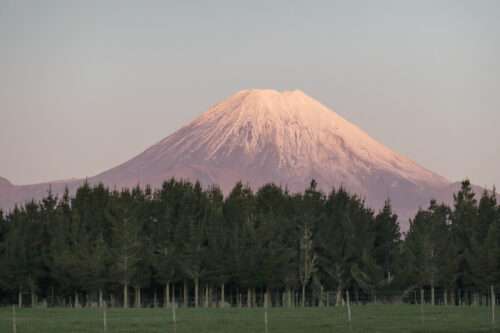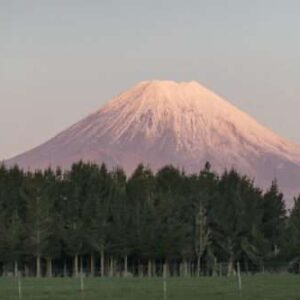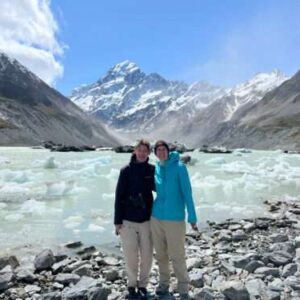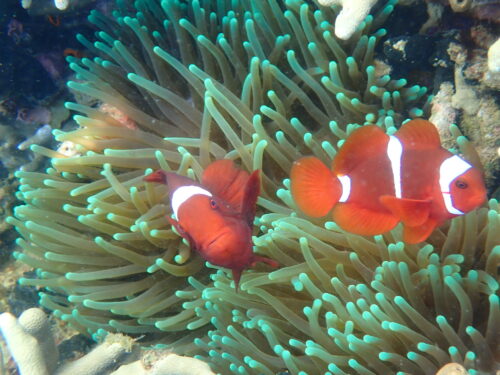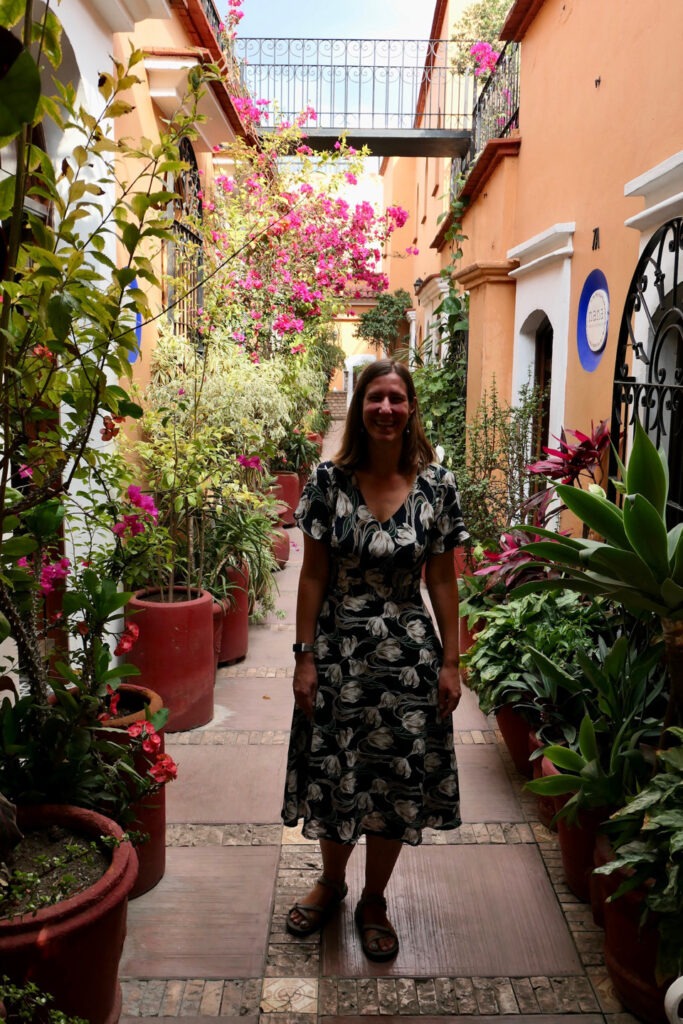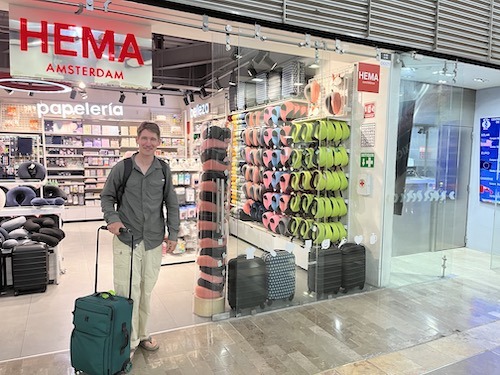Love the outdoors? Is your dream trip hiking in pristine mountains with almost no people? If so, it’s time to plan your trip to New Zealand: incredible landscapes away from all the crowds. Whether you have two weeks, four weeks, or longer, New Zealand deserves to be on any hiker’s bucket list. What you do need to know is that New Zealand is hard to do on a teacher’s budget. How we made it work was by staying in hostels with private rooms but shared bathrooms and kitchens, and in airbnbs with a private room in someone’s home. We got groceries and ate out about 4-5 times in our 33 days, eating a lot of PB&J sandwiches and oatmeal.
While not as luxurious as our time in SE Asia, New Zealand on a teacher’s budget was still a comfortable trip. We spent money on some unforgettable excursions, swimming with dolphins, flying above a whale, seeing penguins and glowworms, and doing three of the Great Walks. The hostels in New Zealand are clean, quiet, pleasant places frequented by families and retirees as much as by younger people: it’s not a party scene, and we were able to sleep well. Everyone goes to New Zealand to be outdoors, so people are generally going to sleep early and waking up early, sharing tips about hikes, and everyone is cooking their own food to have money to spend on excursions.
If you feel overwhelmed and want the itinerary made for you, with exactly where to go, what to do, where to sleep, where to eat, and all other details set, please check out my New Zealand itineraries here. I have a two weeks in New Zealand itinerary and a four weeks in New Zealand version. If you want to plan your trip to New Zealand yourself, here’s my advice!
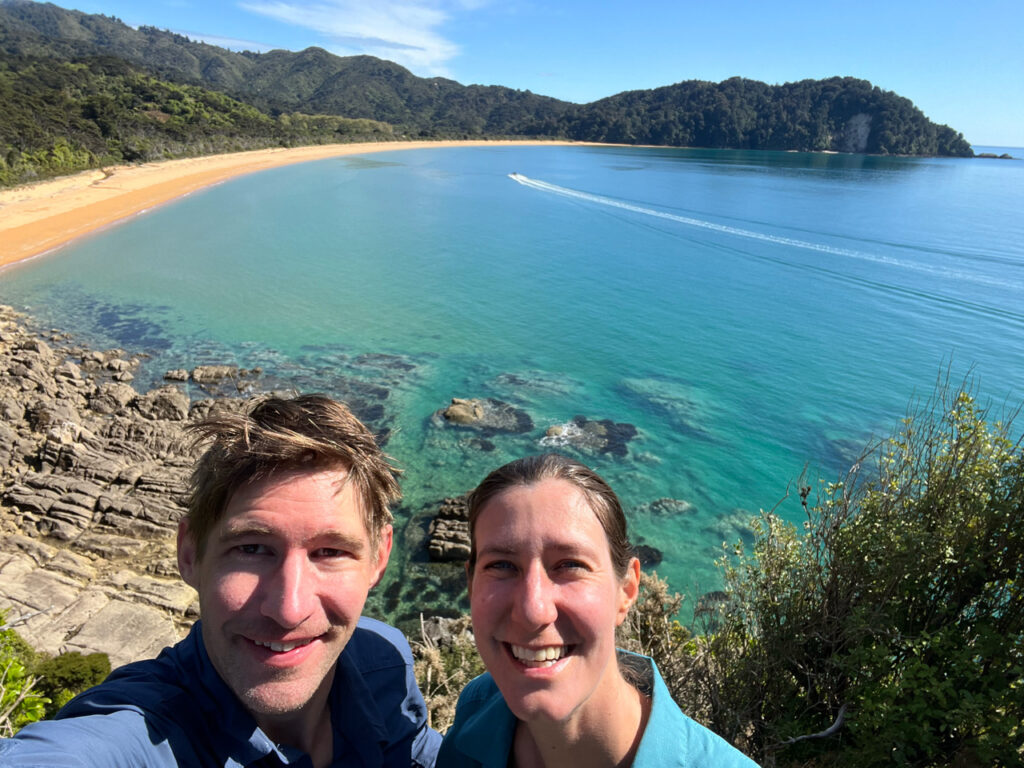
How to plan your trip to New Zealand:
When to go: October- April
Since New Zealand is in the southern hemisphere, if you’re not tied to the school calendar, then October-April can be good, with November and December (before Christmas) having the likeliest good weather to crowds ratio.
Winter break is the best time to go for teachers, as you’ll want at least a two week trip after all the time it takes to get there and travel time around the country (distances are vast!), and our winter break is their summer vacation. Christmas through February is when New Zealanders and Australians have their summer vacations, so crowds and prices go up, though the weather is also the easiest to hike in. You’ll definitely need to book ahead for that time of year.
We went to New Zealand in October during our year off, but if we hadn’t gone then, we would have gone during my winter vacation. We got lucky with our weather in October overall, with not too much rain, though there was still a bit of snow! New Zealand is an incredibly wet, rainy, and cold country, so you will probably get rained on no matter when you go. Bring warmth, rain gear, and a willingness to get wet at any time of the year!
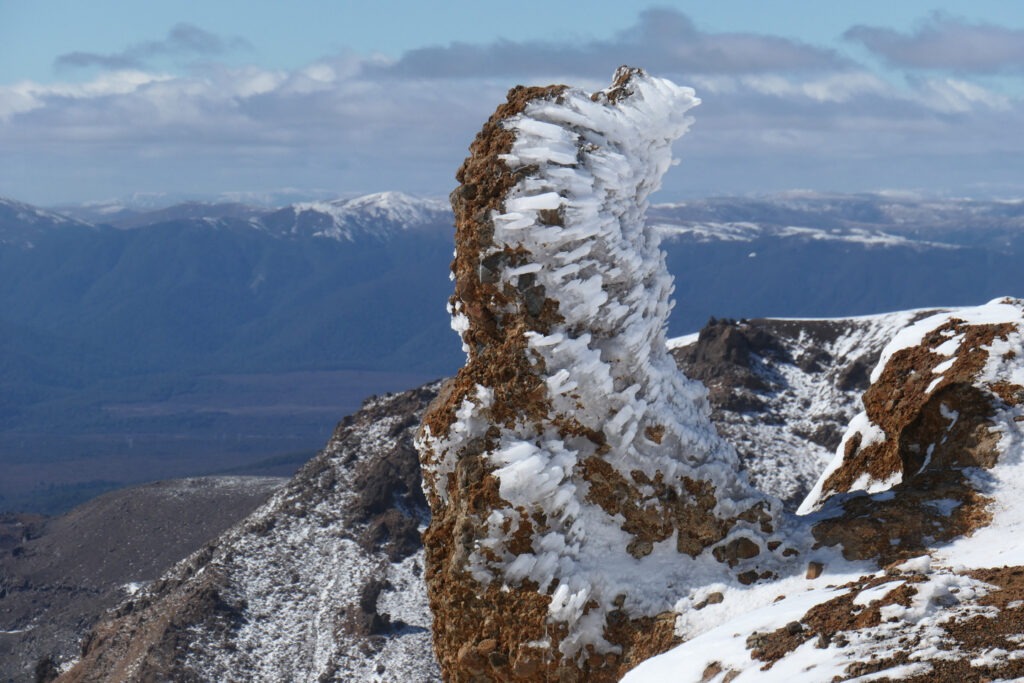
How long to spend on your trip to New Zealand
As long as you can, if you love hiking and the outdoors! You’ll need to drive everywhere, and it will take hours to get to any new place. If you have two weeks, I’d spend the whole time on the South Island. If you have four weeks in New Zealand, then you can spend about two weeks on the North Island and two weeks on the South Island. If you have more time, you can slow down and see even more. On my itineraries, I have options for two weeks, four weeks, and what to do if you have additional days for your trip to New Zealand.
If you’re coming from Australia or other relatively close countries, then you could have a lot of fun in New Zealand for a week. But for everyone coming from Europe or North America, the amount of time and money it takes to get to New Zealand means I’d stay for at least two weeks to justify the effort!
What to book in advance
- The Great Walks! There are 10 Great Walks that New Zealand has created to showcase the absolute best of their many multi-day hikes. Each one is extremely well maintained and organized, with options to camp or stay in huts along the way, with restrooms and kitchens. The Department of Conservation, which maintains all the national parks, has unbelievably detailed guides for each hike, including what to pack and what to expect along the way. You’ll want to figure out exactly when the spots go online (it’s normally in April) and book your spot that same day. Make an account in advance to save time! We stayed in huts for the ones in the mountains, but we camped at Abel Tasman, with its mild weather along the coast, and we loved both experiences.
- Your rental car or camper van: You will definitely need your own wheels for your trip to New Zealand. Especially if you’re going in the high season (December-February), cars and camper vans will be very popular, and the good value options will get booked up. This will be a significant portion of the cost of your trip, so planning ahead will help keep the expenses manageable. We rented a car and stayed in hostels with private rooms and airbnbs, averaging about $50 a night for our accommodations for two people.
- You’ll want to do thorough research on camper van vs. car. For us, our rental car for 33 days was $816 (booked through Chase Travel– use this referral code if you don’t have a credit card with no foreign transaction fees yet and book your vacation with it to get $750 free, like I did!). We didn’t find camper vans for that amount of time for less than $3,500…and for a camper van, you don’t just sleep for free everywhere. You need to park in designated areas, and at least every few days you need to be at a place to connect to wastewater and water facilities (and showers, laundry, and other necessities your camper van won’t have), which cost money each night. If you spend an average of $50 a night on hotels, that’s about $1500 for a month, or about $2500 for a car and place to sleep each night. For us, that was much cheaper than a camper van + the expenses and tiny spaces.
- I’d recommend a car with a good covered trunk, as you’ll want a safe space to leave your luggage (sometimes for multi-day hikes), and space for the groceries you’ll want to carry around with you for making your own breakfasts, lunches, snacks, and dinners. Long lasting milk, oatmeal, dried fruit, bananas, bread, peanut butter, jelly, cans of tuna, muesli, and dehydrated meals for hikes will all be useful to have storage space for, as well as layers of clothes!
- The driving is gorgeous- winding roads through bright green rolling hills, sometimes canyons and gorges, sometimes forests, sometimes a few sheep or cattle. There are SO few people! The roads are incredibly well maintained, and while they do drive on the left side of the road, there are arrows pointing you the correct way to go at almost every tourist destination- they know it’s hard to remember and make it as easy as possible. It’s a very pleasant and easy place to drive, except that there isn’t service for long stretches. Download google maps and start your route when you have service!
- Like everywhere else, I’d recommend bringing your phone unlocked and buying a local SIM card at the airport. It was extremely fast and affordable, and you’ll need the driving directions.
- If you’re going December- February, definitely book your accommodations in advance. Other times of the year, it might not be necessary, but you’ll probably find cheaper and better options. Use my article here to help you book where to stay, or just buy my New Zealand itinerary to have all the accommodations set for you!
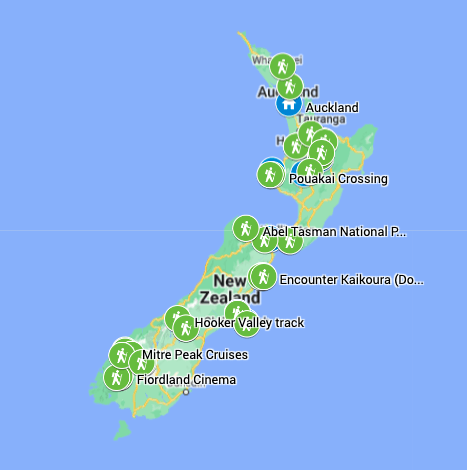
The North Island: If you have four weeks in New Zealand
The North Island is gorgeous, but if you only have two weeks in New Zealand, then I would spend it in the South Island, where there’s a higher concentration of scenery you can’t see anywhere else. But if you have at least four weeks in New Zealand, then some of our favorite places were in the North Island, it’s where the main international airport (Auckland) is anyway, and you’ll see many incredible places you can’t get on the South Island. Here’s what to do on a trip to New Zealand including the North Island!
Auckland
Why go: You’ll almost certainly need to fly into Auckland wherever you’re coming from, and either catch a connecting flight or pick up a rental car. Otherwise, it’s supposed to be a pleasant city to live in but no must-see sights. Go out and see the outdoors you came to New Zealand for!
If you only have two weeks in New Zealand, then I’d take a connecting flight to Wellington or Christchurch immediately, and pick up your car/camper van there.
Poor Knights/ Leigh / Goat Island
Why go: Snorkeling/diving
Things to do: Go snorkeling and/or diving with these two companies:
We were planning on going to these places and using these companies to go snorkeling. They had great reviews, and we were eager to see what snorkeling was like in New Zealand! But when we were supposed to go, there was a massive storm. Both companies were really honest and helpful, and allowed us to cancel for all our money back because they said we wouldn’t be able to see anything with the storm. They sounded like great experiences, and it was the only chance to snorkel or dive in New Zealand. Hopefully you’ll get to go!
Waitomo Caves
Why go: Indoor activity if it’s unpleasant weather but not too much rain or they will be flooded! Chance to see glowworms and caves. Hikes in the area through fern forests and caves.
What makes these caves so famous is….glow worms! Glow worms are only in Australia and New Zealand. They’re really weird creatures- they’re the maggot stage of a gnat, they make dozens of fishing lines out of urea and mucus to trap their prey, and then shine bioluminescence from their dung to attract their prey. But to us looking up at the ceilings of the caves, it looks like little green stars, so beautiful!
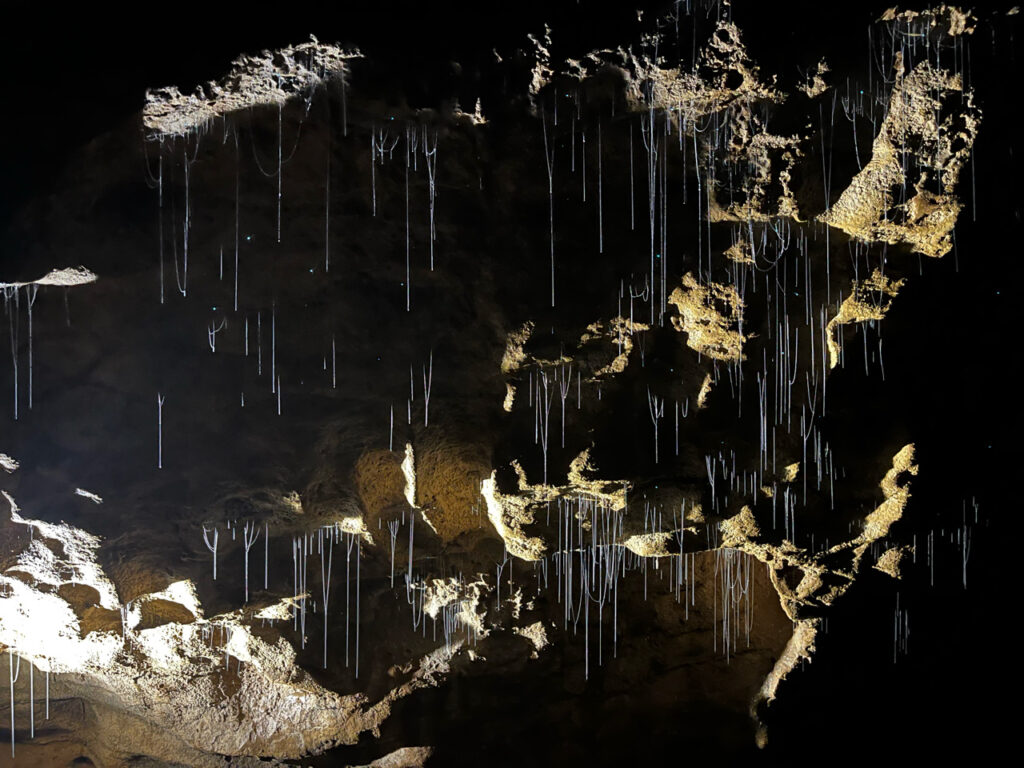
Things to do:
- Visit both gorgeous limestone caves, with incredible stalactites, stalagmites and other formations with glowworms (the third without glowworms I’d only recommend if you haven’t seen many caves before).
- Definitely do the boat ride underneath these “stars.”
- Go on hikes around the area depending on your time and energy. We went on Ruakuri Bushwalk, with lovely cave and fern forest views.
New Plymouth
Why go: One of the best day hikes in the country- Pouakai Crossing around Mt. Taranaki. Lovely botanical gardens at Pukeiti Gardens.
Things to do:
- Hike the Pouakai Crossing around Mt. Taranaki in Egmond National Park, described by the NZ Tourism Board as one of the best day hikes in the country. It’s a long day- we did 40,000 steps/11 miles/19 kilometers, and 414 flights of stairs up- and many more down! But almost all of it is enjoyable, with gorgeous views of the mountain, changing landscapes, and lots of flatter stretches too. The last two hours was all downhill stairs in the same sort of forest, so it definitely isn’t for anyone with weak knees!
- Take a photo at the small lake that reflects the mountain…you might have to wait a bit for the clouds to clear! Do check the forecast at Mt. Taranaki as if the mountain is in clouds the whole day your hike will be much less spectacular.
- For the hike, it is a one way trail, and the official shuttle service was going to be $100 to drive us back to our car (!!!), so chat with others on the hike like we did and find someone to drive you back. Walking just to the photo spot is a popular shorter in-and-out hike, so there were lots of people to ask if you do what we did and end with the lake spot. So either be friendly and hitchhike like we did (not unusual in safe New Zealand), call the official shuttle service in advance and try to share a ride with others to make it affordable, or you could do it as an in and out trail, but then you’d miss half the gorgeous hike.
- Go to Pukeiti Gardens, completely free and open 24/7, with clean bathrooms (including a hot shower if you paid $2!), and enormous and beautiful gardens and local birds frolicking about.
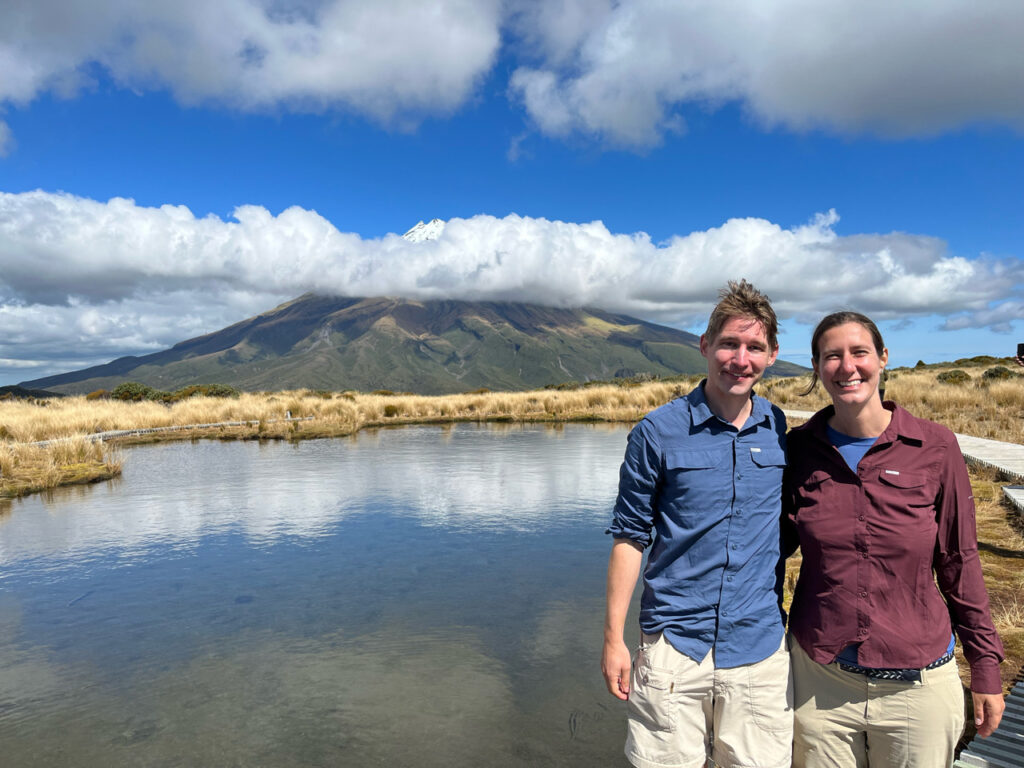
Rotorua
Why go: Geothermal activity and Maori culture
Things to do:
- Explore an extremely active geothermal zone, with sulfur smells everywhere, steam coming out of the ground all over, mud pots and steam vents and boiling water and strange colored lakes in every direction. Walk around the public park in the city center with lovely flowers and walking paths…and mud pots, a foot bath of steam pools, and steaming ponds all around.
- Go to this Māori cultural event, a family owned business whose mission is to preserve Māori culture and teach about it. See traditional war canoes arrive on a river through a native fern forest with a sacred spring with more mud pots and gorgeous clear water. Learn about the famous Haka dance, traditional songs and musical instruments, and traditional weapons, toys, and tattoos. Eat a buffet feast (hangi) that would have been traditionally cooked on coals under banana leaves.
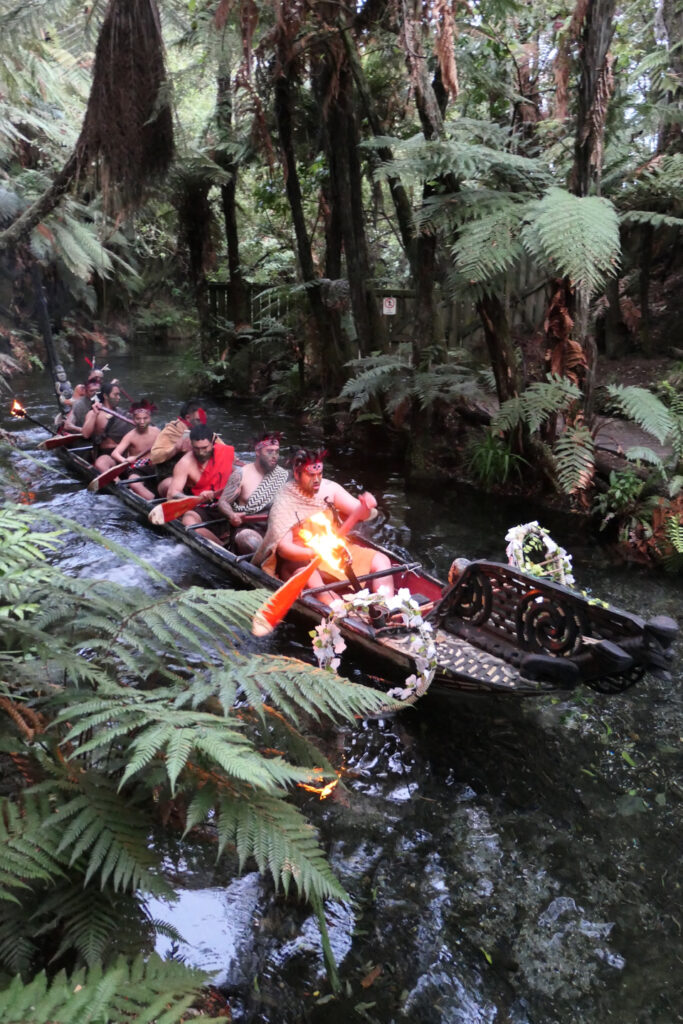
Hobbiton
Why go: For serious fans of the Lord of the Rings…but also for casual fans of movies in general!
Things to do:
- Tour Hobbiton, the set created for The Hobbit, and learn how movie magic happens. The attention to detail is really crazy- like they have clotheslines out, so Peter Jackson had people walk to and from the clotheslines twice a day for two weeks so it would look like people actually live there and use those clotheslines!
- Be aware it is a major tourist site, with tours leaving every 15 minutes with 40 people on a tour each time. But it is also very well run and enormous, so you feel like you have plenty of time (and photo opportunities) at each spot.
- It is a beautiful spot, and there are so many fascinating details- like the oak tree above Bilbo and Frodo Baggins’ house had to be 60 years younger in the Hobbit….so they moved the real oak tree they’d used for the Lord of the Rings, and built an artificial one that would look 60 years younger for the photos you see here- looks real to me!
- It’s expensive, but I’d recommend for anyone at all interested in how movies get made. Neither of us are serious Lord of the Rings fans, but we both found it fascinating.
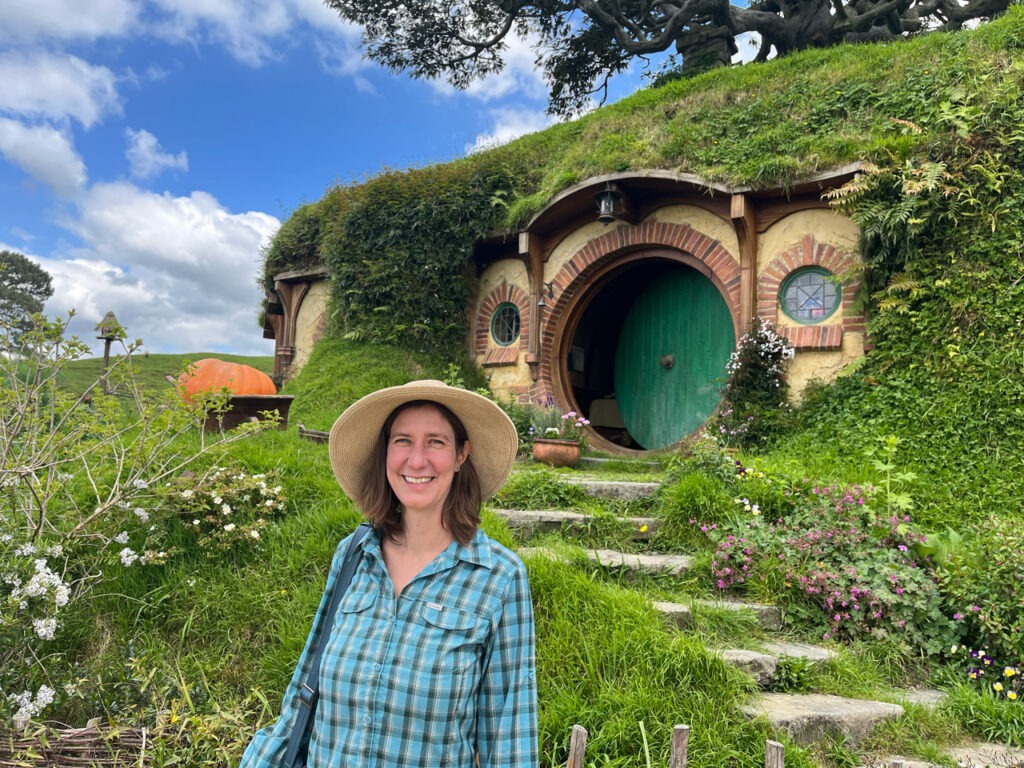
Taupo
Why go: More geothermal activity (thermal baths, mud pots, geysers, etc.) around a beautiful lake with mountains in the background.
Things to do:
- Stay at a lovely Airbnb we’d highly recommend.
- Walk along the river to see Huka Falls, which wasn’t a normal waterfall but rather a narrow part of the river where the walls force the river to go very fast, making a light blue color with all the air mixed in
- Thermal baths at Wairakei Terraces
- Explore Orakei Korako, a geothermal highlight reel of mud pots, geysers, and beautiful colors
- Drive along Lake Taupo to Tongariro National Park with beautiful views
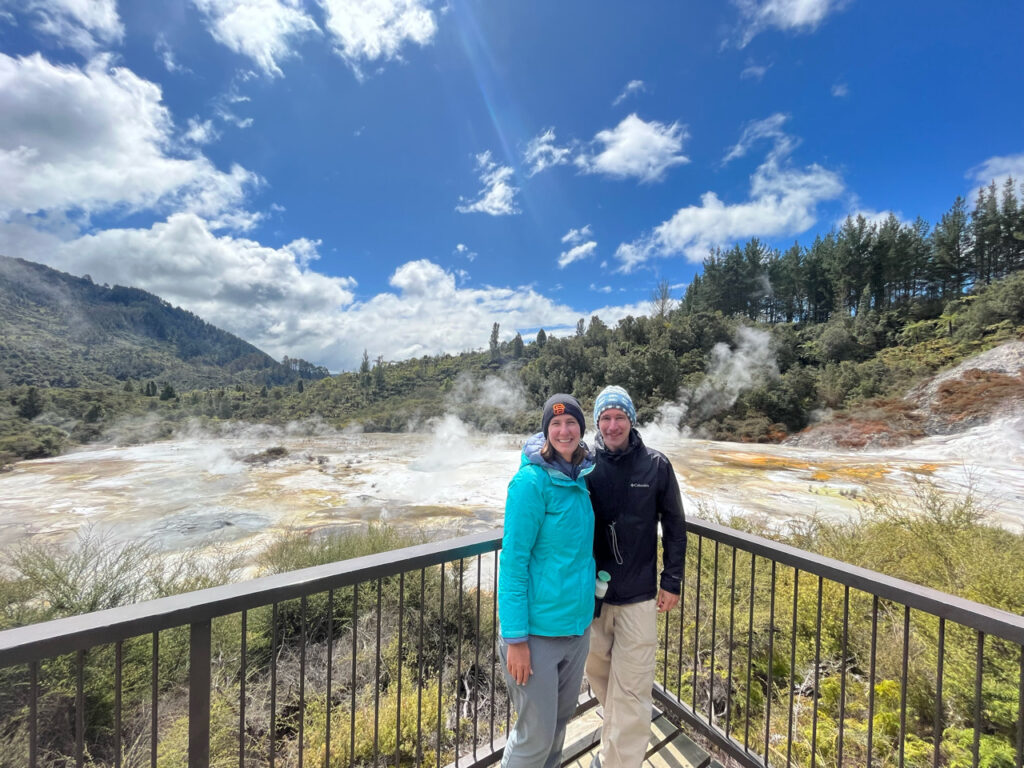
Tongariro Alpine Crossing
Why go: The Tongariro Alpine Crossing, our favorite day hike in New Zealand, and many other people’s favorite too. Absolutely spectacular scenery. Considered one of the best day hikes in the world!
Things to know: Unbelievably gorgeous hike, but it needs good visibility to be able to enjoy it, so use the weather forecast to plan! We had a couple of long driving days because this wasn’t the logical way to get to these places, but we’d heard that this hike was the best day hike in New Zealand. It was rainy with bad visibility earlier in the week, but Friday was looking like clear sky. So we arranged everything to sleep near here Thursday night and hike Friday. After all, who wouldn’t want to see Mount Doom and Mordor from The Lord of the Rings?
You need to arrange a shuttle service, though this one is much more affordably priced. Ours was shared with 6 others. They’ll also give you advice on the current conditions. For us, it snowed the previous two days, so they strongly recommended crampons, which they helped us rent and were invaluable on the icy steep slopes. Take their advice seriously! The crampons the day we went were absolutely necessary, like they said.
You can also pay $195 per person to go with a guide, but I think that would only be necessary if the visibility was terrible- in which case, I wouldn’t bother going. You want to be able to enjoy the views!
When we went in mid October, the high was 2°C/35 °F, and the low was -10°C/ 14°F. But there were also unbelievably beautiful views, sunny and clear! It’s another geothermal area- in fact, it’s a hike around an active volcano, last eruption 2012, so there were steam vents, the crater, sulfur smells, and gorgeous minerals making some of the lakes emerald colored and some bright blue.
There are parts that were steep downhill on ice, and that’s when we needed those crampons. If there had been strong wind, it would have been scary. Do take their warnings seriously, as you walk on a ridge that’s very steep on both sides. For us, it was an incredible adventure, but the two days prior in a snowstorm it would have been a dangerous and miserable slog, guides required and no views. If you can arrange your plans for when there’s good visibility and the shuttle service says it’s safe- it really is the most stunning day hike I’ve ever been on!
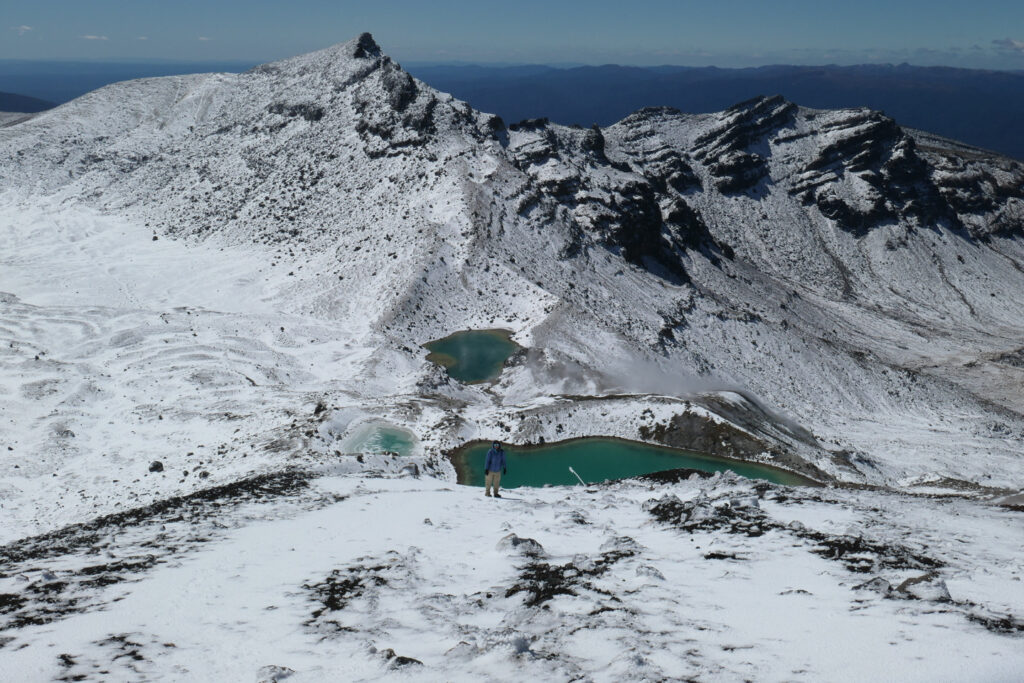
Wellington
Why go: Adorable, livable small town capital of New Zealand (only 200,000 people), jumping off point for the ferry to the South Island.
Things to do:
- Walk around their free botanical gardens
- Eat delicious Malaysian food at Little Penang
- Look at the views from Mount Victoria (you can drive to the top)
- Take the ferry to the South Island (3 hours, easy to take your car too, book in advance if high season)
- Lovely Airbnb
The South Island: Required even on the shortest trip!
The South Island is what you think of when you think of your trip to New Zealand: glaciers, waterfalls, rain, and many more of the most famous scenery of The Lord of the Rings. If you have only two weeks in New Zealand, spend all your time here! If you have more time, spend at least two weeks here. We saw incredible wildlife in Kaikora (dolphins, whales, sea lions), penguins in Akaroa, and went on three of the Great Walks (Abel Tasman, Kepler, and Routeburn). We went on a cruise on the Milford Sound, and did part of that walk as well. We stayed in the hiking mecca of Queenstown, and saw stunning views all over.
The South Island is about the same size as England, or Illinois, but with only 1.2 million people, meaning you’re much more likely to see sheep (2.6 million) than people. It’s full instead of vast landscapes, enormous networks of extremely well maintained trails, and all the outdoors activities you could imagine.
Marlborough Sounds
Why go: Quiet network of hundreds of islands and channels (also known as fjords or sounds). In the summer, there’s snorkeling, kayaking, SUP, and hiking.
Things to do:
- Stay in the Marlborough Sounds itself at a place like Lochmara Lodge, where we stayed, with the possibility to snorkeling, kayaking, SUP, hike, and learn about their animals on land and in water.
- Go with the Pelorus Mail Boat to deliver mail to remote houses spread out all over this enormous area that only has access to the outside world via boat! Our captain and crew were two young women who were hilarious. One resident was on the boat with us making her once a month journey to the “big city” of Havelock, population 588, and coming back with a huge amount of supplies. The mail boat was greeted by the residents to exchange one cloth mail bag for another, and normally a dog, pig, or sheep would come say hi as well- and get a treat from our crew! A memorable experience!
- If you have more time, there are many hikes in this area as well, though we didn’t get to try them.
Abel Tasman Great Walk
Why go: 3-5 day multi day hike, 1 of the 10 official Great Walks that are extremely well maintained and described by the NZ Government. This one has mild weather year round (one of the few that is easily accessible even for camping all year), and the option to kayak, hike, and take a ferry, making it one of the most flexible, family-friendly, and popular hikes in New Zealand. It’s along the coast the whole way, without the serious elevation change or mountain blizzards to worry about. We went in October and had gorgeous sunny days, blue skies, and slept in tents without being too cold.
Things to know:
We hiked the whole trail, which was 100,000 steps and 500 flights over 4 days in Abel Tasman National Park. We chose this park as our first multiday one and our only camping one because of the mild weather (camping is much cheaper than the huts, even taking into account that you need to carry a stove). The government does an extremely thorough job of describing everything you need to bring and be aware of, so just check out their recommendations.
We loved this hike for its golden sand beaches, fern forests, lots of tidal crossings, and swimming opportunities (if you’re okay with very cold water, at least in October!).
Most days you have to time your walk for during low tide. We’d never walked through a bay at low tide before- you see thousands of clams, mussels, crabs, and other shellfish scuttling along.
It would have been a LOT easier with our tevas, but we were trying to pack light…so it was our hiking shoes when possible, but sometimes the water was too high and we had to go barefoot and carry our shoes! Quite the mud bath, sinking deep into the mud, and crunching clams (sorry clams!). Highly recommend sandals or some sort of lightweight water shoe! Other times, we walked through forests or over the golden sand beaches- beautiful but difficult!
In October, it was very quiet, and we were the only ones camping several nights! Most people were in the huts but even those weren’t full. This is an extremely popular area in December- February, when it would have been warm enough to swim, so do book ahead of time, but for us it was quiet and peaceful. We rented camping gear here, which gave us good quality, affordable, lightweight and sturdy gear like a tent, stove, gas canister, and backpacking backpack.
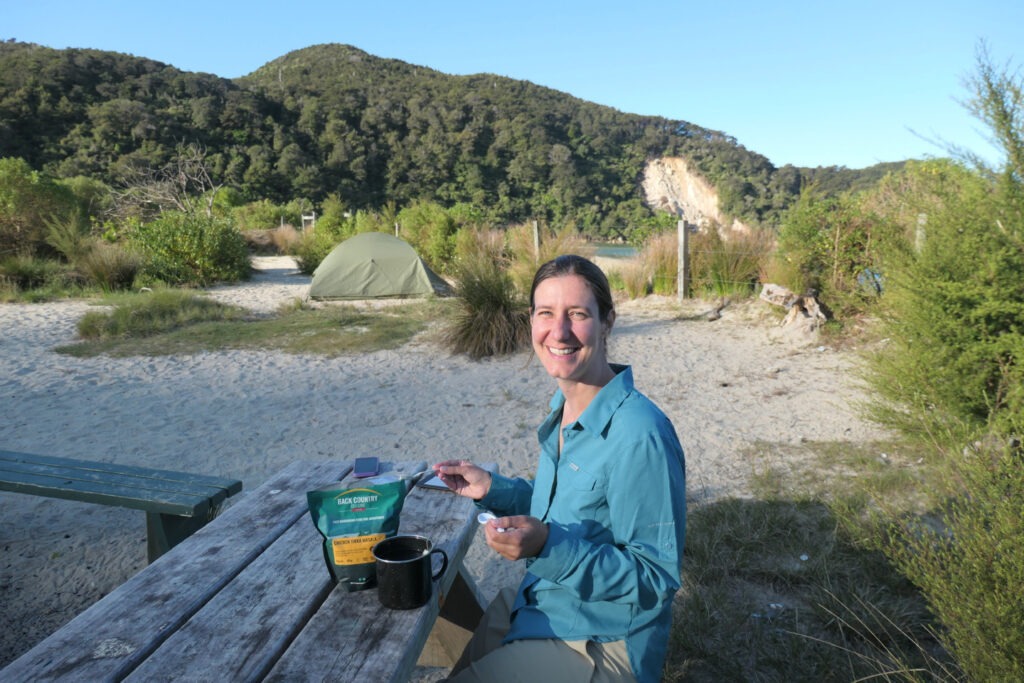
Kaikoura
Why go: Snow-capped mountain on one side, a mile high; the ocean, with a canyon just offshore a mile deep. The ocean topography means whales, dolphins, and seals love it, and we got to spend some unforgettable time with them.
Things to do:
- Swim with the dolphins! It was an incredible experience! They give you all the cold water gear, don’t worry, and they are very well regulated.
- Take a boat or a plane to go whale watching! We actually found a deal online that let us whale watch from a plane for less money than a boat, and being in a tiny plane (GA8) that holds two pilots and six passengers and then finding a sperm whale and watching it from above was another major lifetime highlight!
- Kayak with seals and observe these playful creatures with the snowcapped mountains in the background
- Hike around the peninsula looking at the seals on land with beautiful views- we did this as a sunset walk (just be careful to time the tides correctly!)
- Eat crayfish
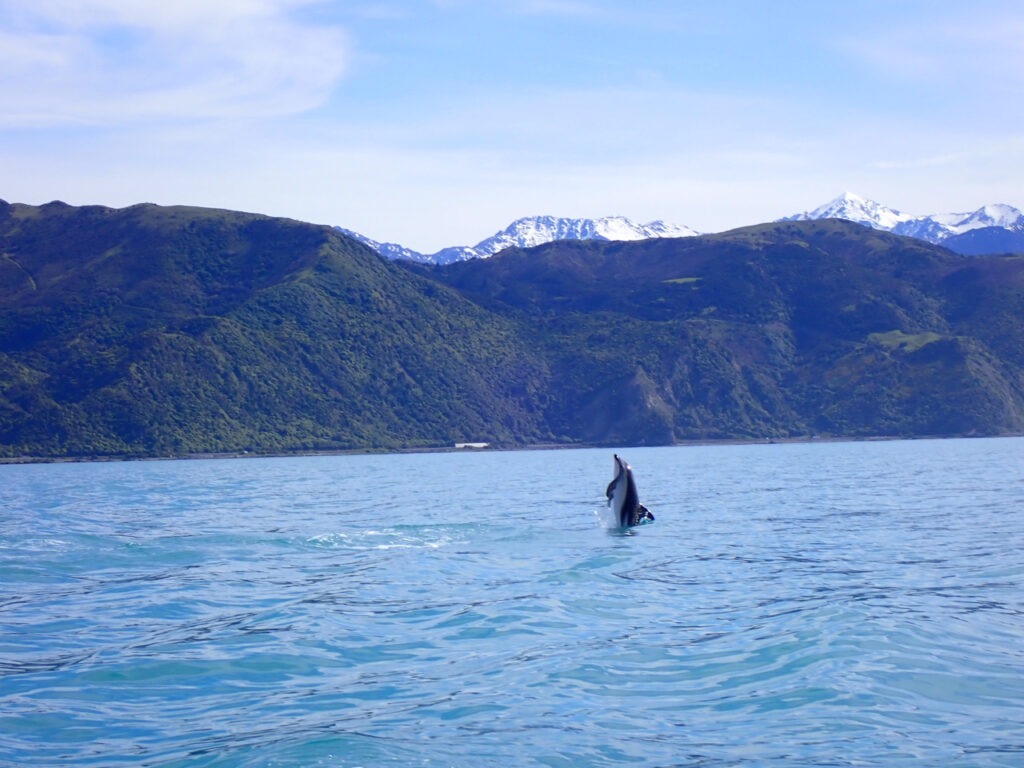
Christchurch and Akaroa
Why go: Christchurch is another livable small town with an airport in New Zealand. To us, it felt very suburban, spread out, with low-lying houses and a small walkable downtown with good food options. I’d only stay there for a nice meal and a convenient airport. Akaroa is much cuter, a former French town, a tiny village with adorable French storefronts and a penguin sanctuary.
Things to do:
- Food hall in Christchurch with excellent Malaysian, Nepali, French, Indian, and many other types of food for affordable prices
- Penguins at Pohatu Penguins (we stayed overnight there to get extra time with them in a memorable location, but the guided tour would have been plenty too)
- Go to The Giants’ House, a whimsical garden full of beautiful, funny, creative mosaics and other artwork. We loved walking around all these imaginative creations!
- Walk around Akaroa with its French bistros, brasseries, boulangeries, cute storefronts, and charming farmer’s market
- Stay at an adorable B&B like this one.
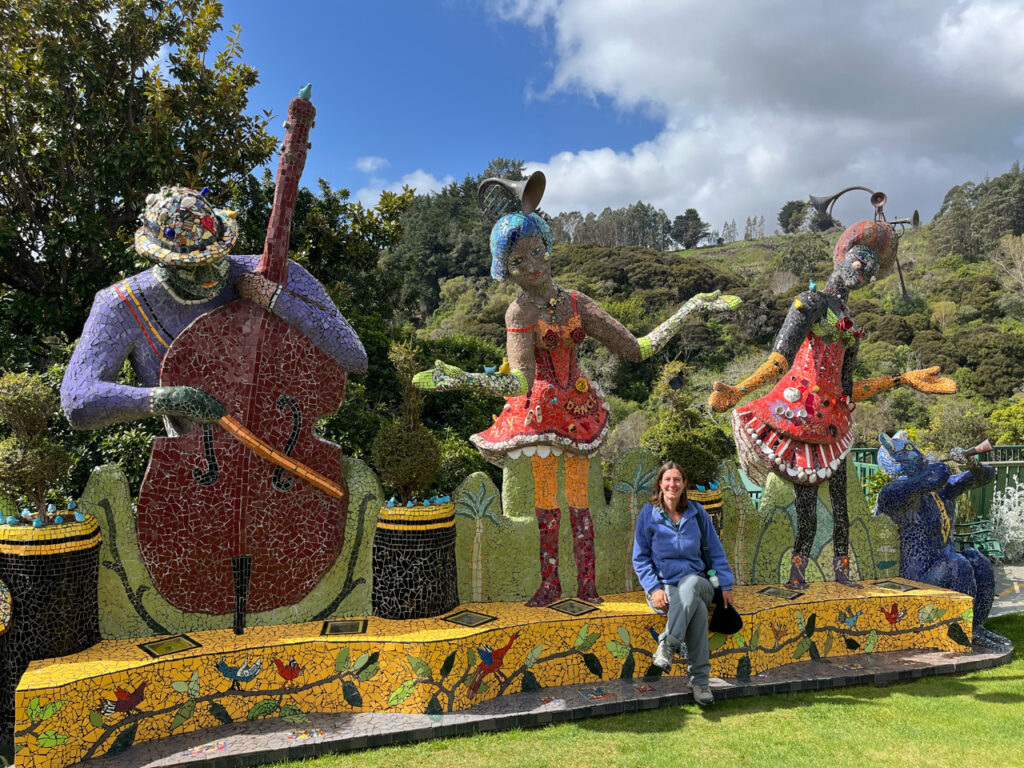
Lake Tekapo and Mount Cook
Why go: Gorgeous scenery, beautiful hikes, official Dark Sky spot, convenient enjoyable stop halfway between Christchurch and Queenstown when driving
Things to do:
- Hooker Valley Track: Gorgeous hike that’s good for all ages with spectacular views of Mount Cook. The trail itself is mostly flat, and we saw a lot of children, but the views are fantastic for everyone to enjoy. There are 3 photogenic suspension bridges, which are a little bit uncomfortable if you don’t love heights, like me, but they are very sturdy and monitored.
- Enjoy the dark skies! There are several (expensive) observatories that let you look through the giant telescopes and see the stars up close. We didn’t do any of them, but if you can, book far ahead of time as they sell out- and plan your trip away from a full moon!
- Relax with a great view where you’re staying: Lake Tekapo is beautiful, with a photogenic old (1930s) church and lots of picnic benches along the lake. This is a good place to recharge, get groceries, do laundry, and go on day hikes before heading for the multi-day big hikes farther south.
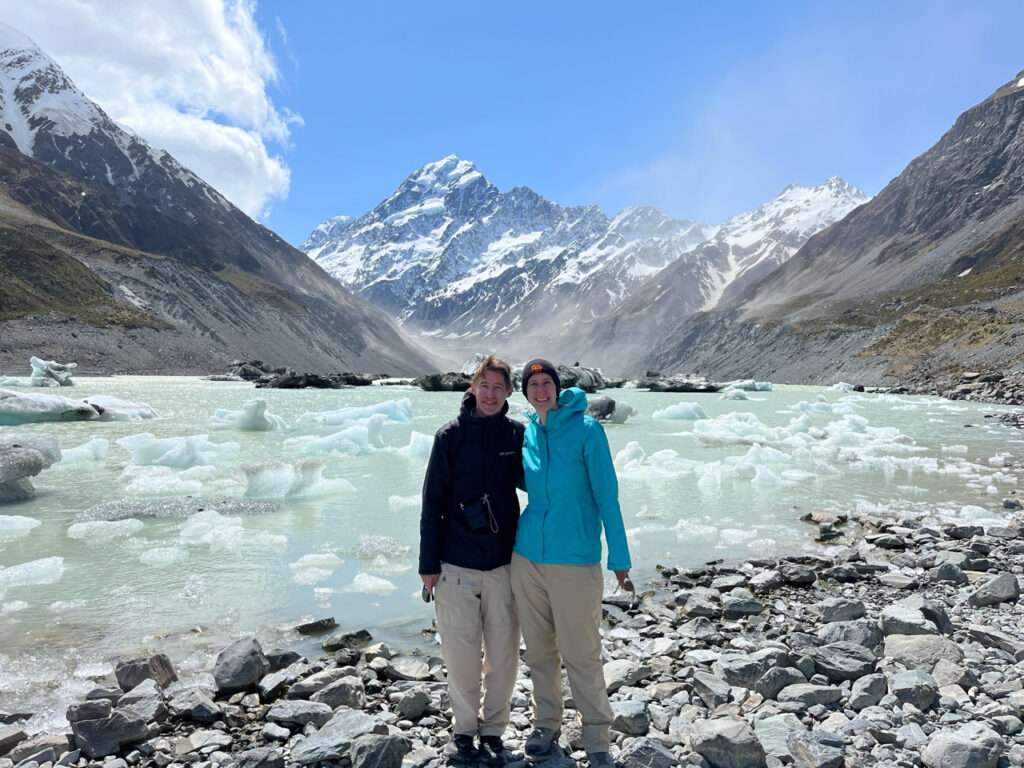
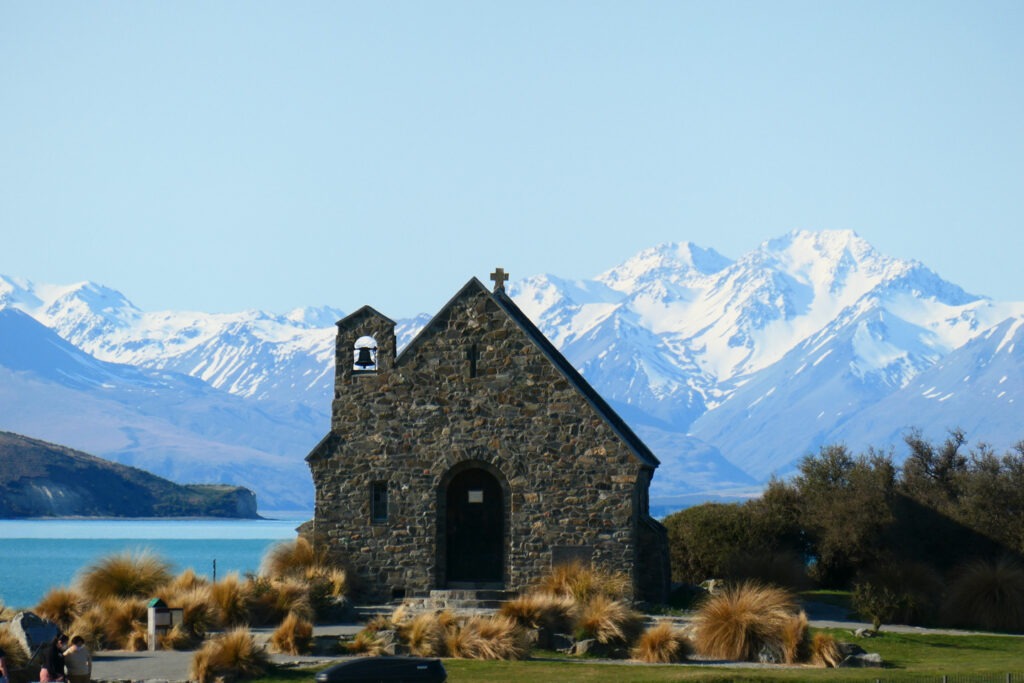
Te Anau
Why go: Your gateway town to the most famous Great Walks- the Kepler, Routeburn, and Milford Sounds. All the supplies and logistics you need to organize your Great Walk are here- as long as you have a reservation to go on them! If not, lots of day hikes and boat cruises are also possible to arrange from here.
Things to do:
- Even on the shortest trip to New Zealand, you’ll want to spend a few nights here and do at least a couple of hikes and a boat cruise on the Milford Sound. If you have extra time, I’d recommend a couple of down days here to get organized for whichever hikes you’re doing and rest. We saw a beautiful short documentary called Shadowland at the little cinema, ate some tasty bao, and did laundry at our comfortable hostel. Definitely stop by the Visitor’s Center to get the latest information about your hike and to register there.
- Milford Sound: This gorgeous fjord with granite cliffs sculpted by glaciers is covered in hundreds of waterfalls every time it rains…and it rains most of the year. It’s a two hour drive from Te Anau, the closest town you can sleep in easily (there is one fancy lodge, and of course the Great Walk- see Milford Track below). Since you’ll be spending four hours getting there and back, I’d recommend “track and cruise” with Mitre Peak so you get to walk a bit of the Milford Track and go on the famous boat cruise for more incredible Lord of the Rings scenery.
- Kepler Track: This incredible multiday Great Walk is a loop, making its stunning scenery easy logistically as you can leave your car at Te Anau and come back to the same point. We did it in 3 days and slept in the huts, which all worked very well for us. The Department of Conservation (DOC) website is extremely informative, as is the visitor center in Te Anau, so use their website and park rangers to answer all your questions. This track was designed to give the best alpine views possible, and it was gorgeous for us- but you do have to be lucky with the weather, as you do need visibility for the views and high winds would have made the alpine crossings nerve-racking for me. Like all Great Walks, booking as soon as the Great Walks go online is essential.
- Routeburn Track: Another incredible multiday Great Walk. This hike was originally a Maori trail to get a prized stone called Greenstone, and it has more stunning mountain views and of course a very well maintained, detailed description of everything you need to know on the DOC website. For this one, you need to pay someone to help you with your car, as it ends a 4 hour drive (325km) away from your starting point. We used EasyHike, and they moved our car safely from Te Anau to the Routeburn shelter, where it was waiting for us with the rest of our luggage in the trunk. They also helped us return the camping gear we had borrowed from Bev’s Tramping Gear Hire. From the Routeburn shelter, it was a beautiful 1.5 hour drive back to Queenstown, so this is a good hike to do when you’re done with Te Anau and ready to go back to Queenstown.
- Milford Track: Another famous multiday Great Walk, also one way so plan ahead for the logistics. This one has booked out for the whole year in minutes, so set an alarm and have your account information already filled in. Sandflies and rain are infamous here though. We did the “track and cruise” instead of this Great Walk as I couldn’t get into the website in time. There are also luxury options for this track and a few others if you miss out and want a guided walk, hot showers, and someone to carry your belongings.
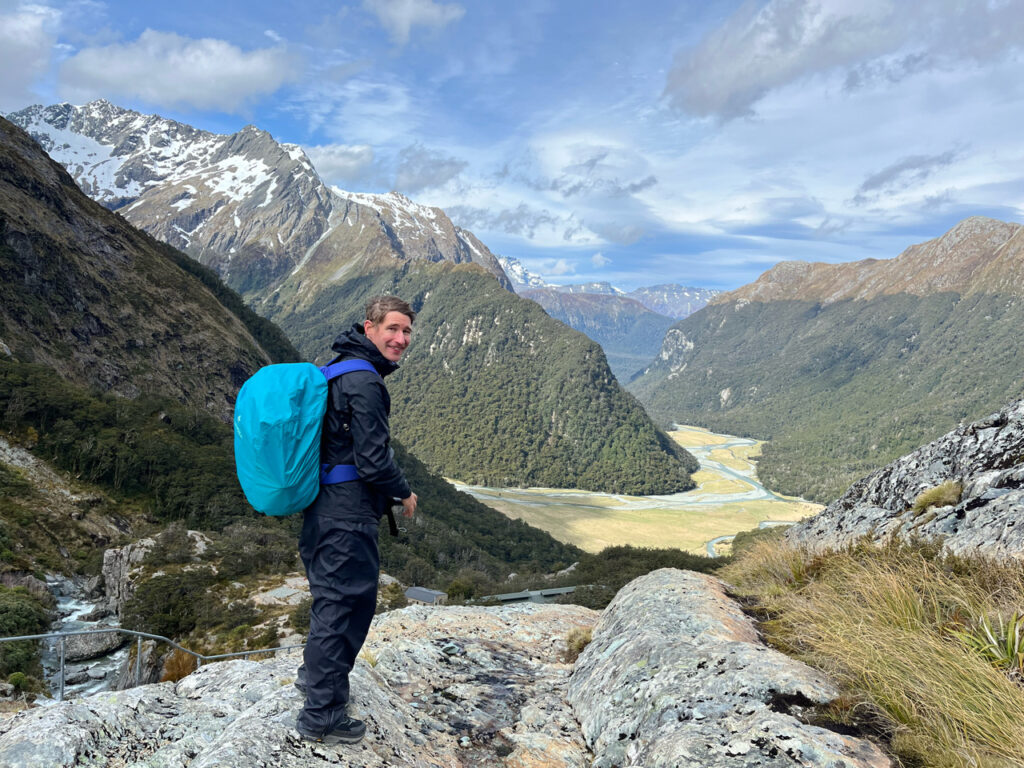
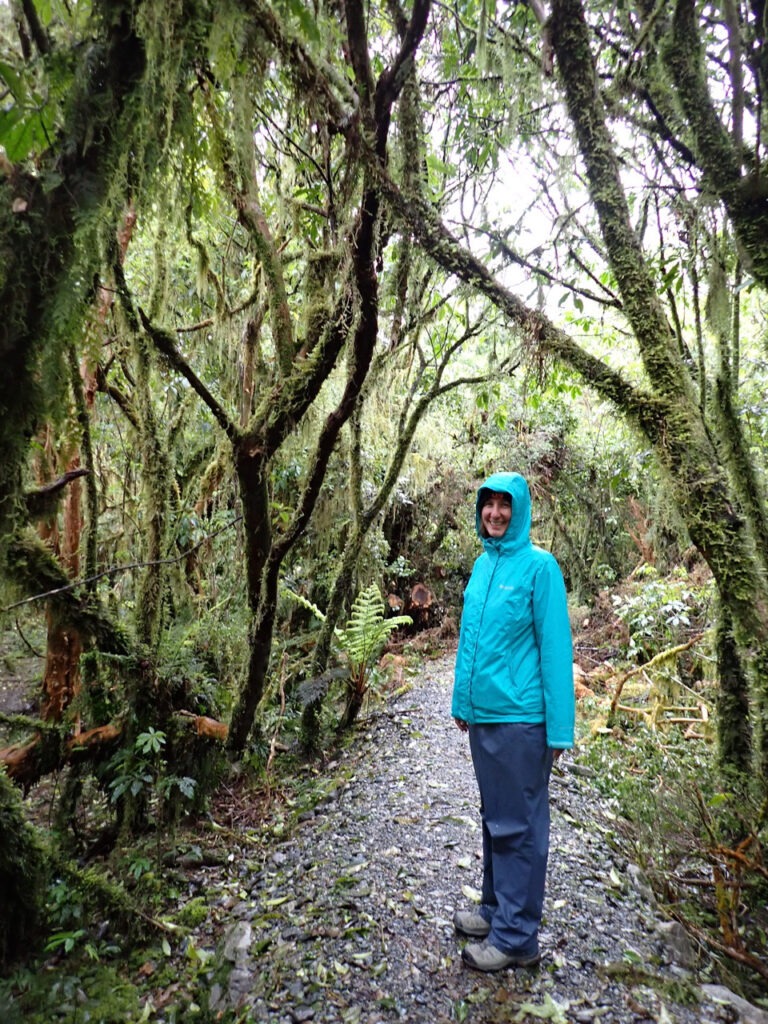
Queenstown
Why go: The capital of the backpacking area, where all your adventure activities can be booked. If you want to go skydiving, bungee jumping, in a helicopter, or any other extreme sport, or just want to go hiking, this is the place to organize everything. Queenstown also has the most food options for the region, if you want one last proper meal!
Things to do:
- Eat good food: We had tasty, cheap savory pies at Fergbaker, which is also a treat to take on the road. They also have a sister place called Fergburger, which has excellent burgers.
- Go on a hike right above Queenstown: We loved the Ben Lomond Track that takes you to stunning views above Queenstown. It’s quite steep, and of course you need good visibility to make it worthwhile, but if you’re lucky like we were, it’s fantastic.
- Take the time to get everything organized for your big hikes. We stayed at Flaming Kiwi Backpackers, which was an easy and helpful home base for us.
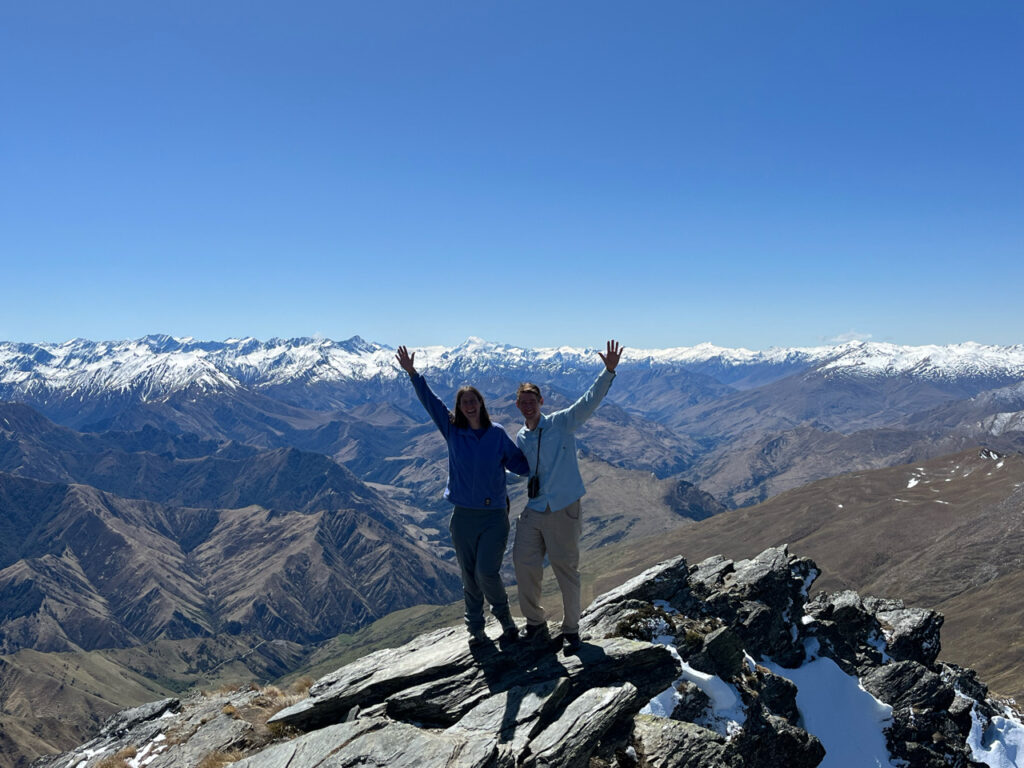
Bottom Line: Plan Ahead, Buy Groceries, Go Outdoors
Now that you have an overview of where to go and what to do on your trip to New Zealand, it’s time to start booking.
If you have four weeks in New Zealand, you can go to all of the places mentioned in this post. If you have two weeks in New Zealand, I’d fly into Christchurch and focus just on the South Island.
As soon as you know your dates, go to the Department of Conservations’ website and figure out when the Great Walks start taking bookings- probably around March/April. Create an account, set a timer, and book your top choice(s) immediately. If you want to hike, go October- April. Make sure the Great Walks you really want to go on will be open then!
Next, rent your car, deciding on a campervan or regular car. Then, start booking your accommodations. If you want help planning your trip, use my itineraries to figure out how long to stay at each place, where to sleep, and exactly what to do. I have a two weeks in New Zealand version and a four weeks version, and each itinerary has ideas of what to do if you have extra days.
For peace of mind, consider downloading the app AllTrails and paying the subscription fee to have offline access to maps of where you’re hiking (or use the free version without offline access). Read all the useful information from the DOC’s website on the hikes you’re doing.
Make sure you have good quality hiking gear, especially shoes, that are broken in and will be comfortable for all the hiking you’ll be doing. Bring warm enough clothes for rain and snow, or be willing to buy if necessary there. When it was much colder than forecasted for us (snow and ice in October), we bought extra warm clothes (and a cooking pot) at the Salvation Army, donating them back when we were done. Consider what you can hire too, if you have warmer trips before/after.
Have a wonderful trip!

